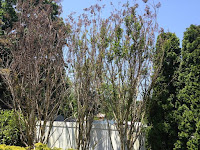Crapemyrtle Pruning and Trimming
Our gardening guru to the south, Neil Perry is one expert who knows his stuff when it comes to correct pruning and trimming of Crapemyrtle shrubs.
Two facts to remember:
• Crape myrtles are a sub-tropical plant. In their native homes they’re not subjected to really cold winters.
• McKinney is north of Dallas, and winters can be rather cold in McKinney. (Respect paid to Amarillo and North Dakota. We still get cold by crape myrtle standards.)
• Crape myrtles are a sub-tropical plant. In their native homes they’re not subjected to really cold winters.
• McKinney is north of Dallas, and winters can be rather cold in McKinney. (Respect paid to Amarillo and North Dakota. We still get cold by crape myrtle standards.)
 |
| Freeze damaged crapemyrtle |
Therefore, we do occasionally see freeze damage to some of the less hardy varieties. Types like Natchez, Tuscarora, Muskogee and the old variety Country Red commonly freeze to the ground. Trim out the dead wood quickly so the new shoots can start filling in.
Game plan here should still be to remove the dead stems carefully. Leave all of the new shoots in place until fall. At that point, select the 7 or 8 straightest stems and leave them. Remove the rest. Next year, perhaps in early summer, the new growth will be sturdy enough to allow the gardener to remove all of the extra stalks and start training the three or five (odd numbers look most natural) that remain.
It’s pretty amazing how quickly crape myrtles regrow. That’s why we also recommend retraining plants that have been butchered (as in “topped”) by cutting them completely to the ground in the winter, then waiting for the regrowth to pop up come spring. Do that one time, and promise your plants that they’ll never be topped again and you can have lovely crape myrtles within 18 months.
Here's his blog http://neilsperry.com/


Comments